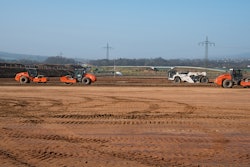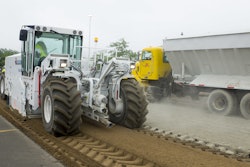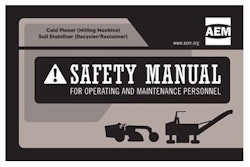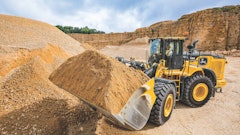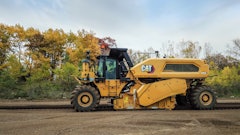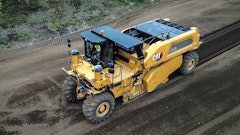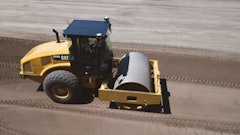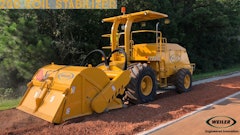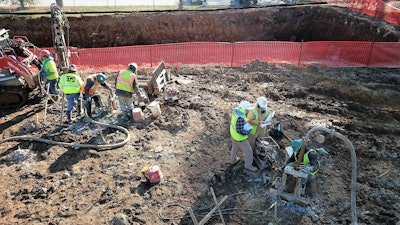
A lone drilling rig hammered away on a muddy, puddle-laden King of Prussia, PA, construction site on an unseasonably cold April morning. Future residents of the five-story, 248-unit suburban Philadelphia apartment complex would someday shuttle back and forth to the various amenities in this bustling community, but no structure could rise from the ground until Compaction Grouting Services, Inc. (CGS) performed its namesake service to tame the poor subsurface conditions.
Media, PA-based CGS was retained by local engineering firm Earth Engineering, Inc. (EEI) and worked as a subcontractor to Western New York-based LECESSE Construction Services. CGS, a DBE-certified ground improvement contractor with a 20-year track record of geotechnical construction experience in Pennsylvania, New Jersey, Delaware and Maryland, has extensive experience correcting the precarious subsurface conditions that plague the King of Prussia area.
Why compaction grouting?
“This whole town is basically a big sinkhole,” quipped CGS Supervisor Steve Oxendine. His experience has been that addressing subsurface issues during pre-construction is far more cost-effective than doing so post-construction.
 Drilling subcontractor Brubacher Excavating used an Atlas Copco ROC D7 Drilling Rig to pre-drill 3.5-inch-diameter holes and install temporary steel casing.
Drilling subcontractor Brubacher Excavating used an Atlas Copco ROC D7 Drilling Rig to pre-drill 3.5-inch-diameter holes and install temporary steel casing.
The compaction grouting process consists of injecting a low-slump, low-mobility, soil-cement grout at high pressures to compact loose, coarse-grained soils and densify and/or displace soft fine-grained soils. A grid-like pattern — pre-determined by a geotechnical engineer — is positioned across the site. Grout columns are then injected into the hole locations within the pattern. Compaction grouting is ideally suited for sinkhole remediation, foundation settlement reduction and soil preparation pre-construction by strengthening soil to withstand higher bearing pressures. It offers a cost-effective alternative to deep foundation systems and underpinning methods.
The apartment building complex will have a 65,000-square-foot footprint founded on spread footings with a partially underground parking garage. CGS drilled 18,061 linear feet at more than 626 hole locations and pumped in 820 cubic yards of grout in total. Some areas of the footing will rest directly on bedrock. When rock was six feet or less below the surface, it was dug out and backfilled with lean concrete. CGS helped to prevent excessive excavation by test drilling in zones where it was suspected that eight-plus feet of digging would be required because of a rock drop-off. In those cases, compaction grouting was a better choice.
 The 2-in. inside diameter temporary casing was equipped with a bullet point on the bottom that was intentionally knocked out by yanking a rope from ground level to avoid clogging the pipe with grout.
The 2-in. inside diameter temporary casing was equipped with a bullet point on the bottom that was intentionally knocked out by yanking a rope from ground level to avoid clogging the pipe with grout.
Navigating crowded, muddy site conditions
The nature of compaction grouting means that CGS crews are accustomed to muddy jobsites, but an unseasonably cold start to spring in Pennsylvania with multiple Nor’easters turned the site into a mud basin. Further complicating matters was that CGS crews were frequently working in areas of low relief, causing them to deal with most of the site's surface water runoff including rain, snow and a tire wash.
CGS Vice President Mike Miluski uses words like lake, pond and swamp to describe site conditions. He recalled one of the firm’s trucks halfway immersed in one such body of water. CGS relied on dewatering equipment to dry out the puddles and air compressors to blow off the snow. “We always deal with mud,” Oxendine said.” With compaction grouting you never have ideal sites.”
 Mike Miluski, CGS VICE PRESIDENT, checks the temporary casing to prepare for grout injection.
Mike Miluski, CGS VICE PRESIDENT, checks the temporary casing to prepare for grout injection.
A multitude of tightly spaced holes
The site was crowded by more than workers and equipment. The sheer volume of holes in such a tightly packed area meant that CGS crews would not be able to address every other hole. No hole within eight feet could be touched within 12 hours so they were required to grout every third hole. Most of the grout ports were clustered on the southern and northeastern quadrants of the site.
Oxendine, whom supervised the project from the front lines, considered managing the quantity of holes in the condensed area the greatest challenge. “The paperwork was daunting,” he recalled, noting that it was critical to cross-check the plans and survey stakes to stay organized. Keeping the stakes in place and undamaged was also difficult as the various trades on site navigated the obstacle course on foot and in machinery.
Drilling into bedrock and casing holes
CGS subcontracted the lion’s share of drilling to East Earl, PA-based Brubacher Excavating, which supplied a manned Atlas Copco ROC D7 Drilling Rig. The rig was constantly pounding away to pre-drill the holes and install temporary steel casing.
 CGS generally pumped 20 to 50 cubic yards of grout per day while utilizing two to three crews.
CGS generally pumped 20 to 50 cubic yards of grout per day while utilizing two to three crews.
The original spec required CGS to drill three feet into bedrock, which lied at varying depths from 15 to 60 feet. Drilling was cut off at 50 feet if no rock was encountered. Excavation on one corner of the site turned up 5- to 6-foot boulders, some of which jutted out from stockpiles and embankments around the site. CGS had to bore an extra two feet in this zone to ensure the drill was hitting bedrock.
Mixing and pumping grout
“It's (grout) tightening up the soils as we pump,” Oxendine hollered over the machine gun-like hammering of a nearby drill. “The pressure surge (maximum injection pressure), on this job is 500 psi. That's a lot of pressure pumping all that grout down in there and compacting that soil.”
The site contained a mix of dense clay soils and softer karst conditions. Miluski noted that a normal soil profile would typically increase in strength with depth. With karst conditions, the dense clays are up top and the weaker soils are just above bedrock because of water flowing above the rock formation.
There is no surefire way to determine exactly how much material a hole will take. The variables include depth to bedrock, soil conditions, and groundwater level. The refusal criteria on the site required CGS to pump grout ranging from 54 cubic feet per foot at 50 psi or below, 27 cubic feet per foot at pressures between 50 and 150 psi, and 5 cubic feet per foot at pressures from 150 to 500 psi.
 The refusal criteria on the site required CGS to pump grout ranging from 2 yards per foot below 50 psi to 5 cubic feet for 150 to 400 psi.
The refusal criteria on the site required CGS to pump grout ranging from 2 yards per foot below 50 psi to 5 cubic feet for 150 to 400 psi.
“The higher psi tells you that the soils are pretty good or you’re in rock,” Miluski explained, adding that a significant number of holes took less grout since the rock was higher than anticipated. “The soil has been relatively good and that helped our schedule.”
CGS generally pumped 20 to 50 cubic yards of grout per day while utilizing two to three crews. The grout was produced using a mobile mixer with sand and cement in the hopper and a 500-gallon water tank hooked up to a Putzmeister grout pump. This pump is specifically designed for injecting grout at high pressure. “We were averaging between 15 and 20 holes a day,” Oxendine recalled. “At one point we had three pumps and two mobile mixing trucks going at the same time because some of these holes were 50 to 60 feet deep.”
The mix of water, cement, and sand is crucial in compaction grouting, according to Miluski. The specification called for a 300-psi compressive strength and 8% to 10% cement, a relatively standard specification. Due to CGS' experience he stressed that the gradation of the mix is what really counts. “The more cement you have, the more it travels in the ground,” he said of the grout. “You want it to be like a growing mass.” Number eight crushed stone (3/8- to 1/2-inch) was added to prevent the viscous grout from seeping into rock fissures.
Bidding lump sum to mitigate the GC’s risk
“This isn't a unit job,” Miluski said, looking out over the site. “There's serious risk involved in giving a hard number.”
It was initially a unit price project until CGS offered to bid it lump sum as the company does on many compaction grouting projects. This helped to mitigate risk and instill assurance and confidence for its western New York-based general contractor LECESSE.
Terry agreed. He believes there are other subcontractors that could have done the work, but doubts that they understand compaction grouting well enough to bid the project lump sum.
 Backpressure from the soil forced the grout out of the pipe.“It's really a crapshoot,” he explained. “How deep are we going to have to drill? How much volume (of grout) are the holes going to take? As an owner who's not as familiar with it, it's scary for a lot of them to think that they have the exposure of a possible $100,000 swing.”
Backpressure from the soil forced the grout out of the pipe.“It's really a crapshoot,” he explained. “How deep are we going to have to drill? How much volume (of grout) are the holes going to take? As an owner who's not as familiar with it, it's scary for a lot of them to think that they have the exposure of a possible $100,000 swing.”
It is not uncommon for compaction grouting projects to have 10% to 20% swings when comparing estimated drilling and grout volume quantities to actual quantities. Spread over a large magnitude (600-plus grout locations), the associated additions and deductions associated with unit costs can kill a project budget or sink a contractor. By providing a lump sum, CGS eliminated the risk for the owner while betting on its own knowledge, experience and production.
Finishing ahead of schedule
Project delays up front put CGS on the site in February at the tail end of a cold winter that would bleed into a chilly spring. The crew geared up, working through snow, rain, and chilly temperatures amidst knee-deep puddles, mud and the occasional snow mound.
In addition to schedule adjustments, tight working quarters, and excessively muddy conditions, a sinkhole opened where foundations were founded on rock in an area where grouting had not been performed. Due to experience and CGS’ onsite mobile mixing grout trucks, they were able to immediately mitigate this sinkhole by adjusting the grout mix to pump in high-mobility grout. There was no need to wait for cement delivery or a neat cement mixing truck to arrive onsite.
The pressure stayed on as the contractor that would be constructing the footers bore down on the CGS crews. Despite the challenges, CGS delivered the job a day earlier than expected. This was meaningful on a 40-day project with the aforementioned variables. Not to mention, CGS took on an additional 13 holes at the engineer’s request and improved upon its track record of completing a job on time.
“It's a big job, but we try to do it as fast as we can,” Oxendine said of the 12 workers that make up his crew. “We work long hours and we get it done.”




